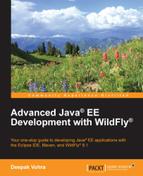Book Description
Your one-stop guide to developing Java® EE applications with the Eclipse IDE, Maven, and WildFly® 8.1
In Detail
This book starts with an introduction to EJB 3 and how to set up the environment, including the configuration of a MySQL database for use with WildFly. We will then develop object-relational mapping with Hibernate 4, build and package the application with Maven, and then deploy it in WildFly 8.1, followed by a demonstration of the use of Facelets in a web application.
Moving on from that, we will create an Ajax application in the Eclipse IDE, compile and package it using Maven, and run the web application on WildFly 8.1 with a MySQL database. In the final leg of this book, we will discuss support for generating and parsing JSON with WildFly 8.1.
What You Will Learn
- Use Maven to develop and deploy Java EE applications with WildFly 8.1
- Develop Java EE applications for WildFly 8.1 using the Eclipse IDE
- Create an EJB 3.0/JPA-based application with WildFly 8.1
- Familiarize yourself with object-relational mapping with Hibernate 4
- Build and package a JSF 2.0 Facelets application with Maven and then deploy it in WildFly 8.1
- Build a JAX-WS 2.2 web service and a JAX-RS 2.0 RESTful web service and learn how to use Spring MVC 3.1
Downloading the example code for this book. You can download the example code files for all Packt books you have purchased from your account at http://www.PacktPub.com. If you purchased this book elsewhere, you can visit http://www.PacktPub.com/support and register to have the files e-mailed directly to you.
Table of Contents
- Advanced Java® EE Development with WildFly®
- Table of Contents
- Advanced Java® EE Development with WildFly®
- Credits
- About the Author
- About the Reviewers
- www.PacktPub.com
- Disclaimer
- Preface
- 1. Getting Started with EJB 3.x
- Setting up the Environment
- Creating a WildFly runtime
- Creating a Java EE project
- Configuring a data source with MySQL database
- Creating entities
- Creating a JPA persistence configuration file
- Creating a session bean facade
- Creating a JSP client
- Configuring the jboss-ejb3-ejb subproject
- Configuring the jboss-ejb3-web subproject
- Configuring the jboss-ejb3-ear subproject
- Deploying the EAR module
- Running the JSP client
- Configuring a Java EE 7 Maven project
- Summary
- 2. Developing Object/Relational Mapping with Hibernate 4
- Setting up the environment
- Creating a Java EE web project
- Creating a Hibernate XML Mapping file
- Creating a properties file
- Creating a Hibernate configuration file
- Creating JSPs for CRUD
- Creating the JavaBean class
- Exporting schema
- Creating table data
- Retrieving table data
- Updating a table row
- Deleting a table row
- Installing the Maven project
- Running a schema export
- Creating table rows
- Retrieving table data
- Updating the table
- Deleting the table row
- Summary
- 3. Developing JSF 2.x Facelets
- 4. Using Ajax
- 5. Using GWT
- Setting up the environment
- Running the starter project on WildFly 8.1
- Creating a GWT project in Eclipse
- Deploying the starter project to WildFly 8.1
- Running the starter project on WildFly 8.1
- Creating a new GWT project
- Creating a GWT module
- Creating an entry-point class
- Creating an HTML host page
- Deploying the GWT project with Maven
- Running the GWT project
- Summary
- 6. Developing a JAX-WS 2.2 Web Service
- 7. Developing a JAX-RS 1.1 Web Service
- 8. Using Spring MVC 4.1
- Setting up the environment
- Creating a Spring MVC project
- Creating a JPA configuration file
- Creating the Model
- Creating the Data Access Object design pattern
- Creating a web descriptor
- Creating a request handler
- Creating the View
- Creating a Spring MVC context
- Deploying the Spring project with Maven
- Creating deployment structure and infrastructure deployment descriptors
- Installing the Spring MVC Maven project
- Running the Spring MVC application
- Summary
- 9. Using JAX-RS 2.0 in Java EE 7 with RESTEasy
- 10. Processing JSON with Java EE 7
- Index
